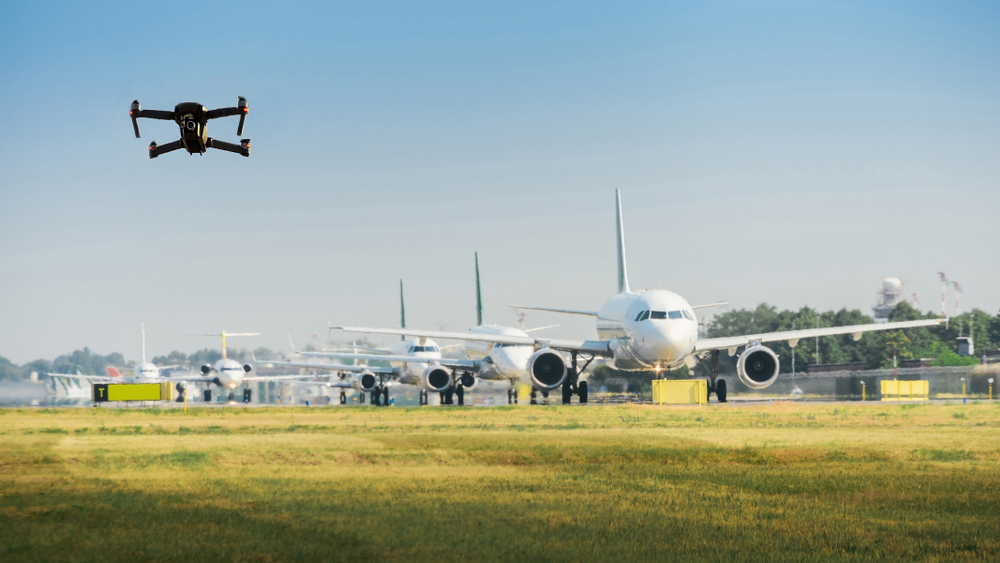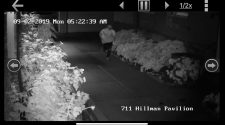Airports are slowly getting back to business amid the coronavirus crisis. While that’s a hopeful development for the travel industry, airports will need to plan for an ever-increasing threat of disruption from unauthorized drones overhead.
The last time an incident was widely reported was February 3, about a month before the pandemic started grounding planes. Madrid closed its international airport for two hours that day due to drones sighted in the airspace.
Over the past year and a half, unauthorized drone activity has shut down Gatwick and Heathrow airports in England, and international airports in Dubai, Dublin and Newark, New Jersey.
These incidents are increasing even though it is illegal to fly a drone higher than 400 feet, in restricted airspace, or within a kilometer of an airport.
“You have uneducated hobbyist operators who just don’t know all the regulations about drones,” explains Sarig Lev, business development manager for drones and anti-drone solutions at Israel Aerospace Industries subsidiary ELTA Systems.
“And on the other side,” Lev continues, “there are malicious operators who intend to cause harm.”
ELTA Systems’ Drone Guard on the job. Photo: courtesy
That’s why technologies to detect and disable these unmanned aerial vehicles are in hot demand.
Like birds, drones weighing only a couple of pounds — too small to be detected by traditional radar– can seriously damage aircraft.
Drones also present a threat to terminal buildings, Lev says. And there’s a possibility they could be carrying explosives.
Therefore, airports must always be on the lookout for drones to avoid expensive, aggravating shutdowns and flight cancellations, or worse.
Here we look at Israeli solutions to a dangerous problem plaguing airports across the world.
Drone Guard by ELTA Systems (IAI)
ELTA began developing Drone Guard in 2016 for military and civilian uses. Hundreds of have been sold since 2017, but Lev explains that development is always evolving.
“The drone business is like smartphones – there are always new models and new threats, and we must adapt,” says Lev. “The variety of drones and the easy accessibility is increasing all around the world.”
Drone Guard has provided protection for events such as the 2018 G20 Buenos Aires summit. The system recently was tested successfully at a naval NATO exercise in Portugal and at international airports in Europe, Latin America and Southeast Asia.
Lev says the most critical component in Drone Guard is 3D X-band radar that detects and tracks all types of drones without interfering with airport radar systems.
“It sees all movement in the sky and distinguishes drones from birds, for example.”
The multilayered system also includes communications intelligence to “listen in” to communication between the operator and drone; an electrooptical/infrared camera to visualize and classify the drone; and a jammer that neutralizes or takes over the drone and steers it to a designated safe place.
The newest capability will be launching an interception drone from a docking station.
The modular, transportable system can be tailored for each customer – for example, downsized to fit in a backpack or upsized to provide long-range radar for large airports. One command-and-control unit manages the system.
Drone Dome by Rafael Advanced Defense Systems
Drone Dome from Rafael Systems (maker of Israel’s anti-missile Iron Dome) is designed to operate in highly congested civilian or military airspaces.
The system employs electro-optics, radar and signal intelligence to identify the target, send alerts and take down the drone in a controlled way, either by jamming its radiofrequency signals or destroying it with a focused laser beam.

A Drone Dome battery. Photo courtesy of Rafael Advanced Defense Systems
Using a specific jammer bandwidth and advanced directional antenna keeps Drone Dome from interfering with planes in the airspace. The modular system can be set up in a stationary or mobile configuration, tailored to each customer.
Although it was widely reported that Drone Dome systems purchased by the British military helped end the Gatwick crisis in December 2018 – which paralyzed the airport for 36 hours and stranded more than 100,000 travelers – in fact the Israeli systems had not yet been delivered and a different solution was found.
Convexum
Airports are among the varied international customers of Convexum, founded in 2015 by former members of the IDF’s renowned 8200 signal intelligence unit.
Given the founders’ expertise, it’s not surprising that Convexum uses cybersecurity techniques to mitigate drone threats within a range of 1.5-kilometers (close to a mile).
Once a suspicious drone is detected using radio frequency sensors, a technology called protocol manipulation (spoofing) allows the UAV to be taken over automatically or manually.
Convexum claims to be the only solution on the market that can even detect when an unauthorized UAV is turned on within the protected perimeter and prevent it from taking off.
The technology currently is effective against about 80 percent of consumer drones, including nine out of 10 of the top models – “with more added in every version,” according to the company.
In February, Israeli cyber intelligence and surveillance company NSO acquired Convexum for $60 million.
Other Israeli counter-drone products
The growing threat from drones doesn’t only affect airports, of course. In September last year, Houthi rebels from Yemen used drones to strike two key oil installations inside Saudi Arabia, damaging facilities and cutting the country’s oil production by about half – some 5% of global oil production.
Drones operated by hostile actors are an increasing threat to military settings, border crossings and sensitive infrastructure such as power plants and reservoirs.
ELTA’s Sarig Lev says that because there are so many types of drones with different capabilities, multiple solutions are needed.
To that end, ELTA North America is the exclusive marketer in the United States for D-Fend Solutions in Ra’anana.
Founded in 2017, D-Fend co-developed the EnforceAir counter-drone system for urban environments in partnership with the US Department of Defense.
In 2019, EnforceAir was deployed in more than 20 sites operated by US military, the FBI and the Customs and Borders Patrol.
EnforceAir automatically and passively detects, locates and identifies unauthorized drones, taking control and landing them safely at a predefined safe zone. It does not use a jamming technology and does not require a line of sight.
The US Defense Innovation Unit — which accelerates the adoption of commercial technology and methodologies for national security for Department of Defense customers – chose EnforceAir as the core radiofrequency system for a government-sponsored counter-drone solution.
“We are proud to be a unique and essential part of a mission critical solution that protects US assets, troops and citizens,” said Zohar Halachmi, chairman and CEO of D-Fend.
Aside from home grown solutions in Israel, you can also find Israeli components powering counter-drone systems of other companies.
For example, advanced radar from RADA Electronic Industries in Netanya is inside the X-MADIS counter-drone system made by US-based Ascent Vision Technologies for applications including airport protection.



















